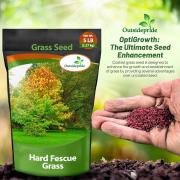Fungal diseases do occasionally appear on a fescue lawn, but there is no reason to panic. Fescue is not particularly prone to disease and most people will grow their lawn for years and years without spraying a fungicide. Occasionally a fungal disease appears under the right environmental conditions, but they usually fade away as the weather changes.
Nonetheless, always be prepared to act if brownpatch, dollar spot, leaf spot, pythium, or rust arrives on your lawn. These diseases are often prevalent in the spring and fall when daytime air temperatures are 60-80°. During these times, it is best to switch to a day-time or early morning irrigation schedule so that the moisture will evaporate quickly.
Fungal diseases are difficult to identify and are often attributed to other problems. In fact, many spring disease outbreaks are ignored until the diseased area grows into a sizeable problem. The best advice is to take a good look at your lawn every couple of days and to be aware of anything abnormal. In general, fungal diseases appear as brown or damaged patches of grass with clearly defined outlines.
If you find a lawn that fits this description, don’t run out and spray the entire lawn with a fungicide. Wait to see if the patch of damaged grass expands over the next day or two. It is quite possible that the fungal disease will run its course naturally. An ‘active’ patch of diseased turf will grow and expand concentrically over a couple of days.
All Products
My Cart
Account
Menu
-
CLOVERS
Alsike Clover Seeds Arrowleaf Clover Seeds Berseem Clover Seeds Clover King Deer Food Plot Seed Crimson Clover SeedsCrimson Clover Seeds - White Fixation Balansa Clover Ladino Clover Seeds Lespedeza Capitata Seeds Miniclover Seeds
-
COVER
CROPS - DEER
-
FLOWERS
Abutilon Seeds Acanthus Seeds Aconitum Seeds African Daisy Seeds (12) Agastache Seeds (8) Ageratum Seeds (5) Agrostemma Seeds (3) Ajuga Seeds Allium Cernuum Seeds Alstroemeria (2) Alternanthera Seeds (1) Amaranthus Seeds (11) Ammobium Alatum Seeds Anemone Seeds (3) Angelonia Seeds (7) Annual Short Seeds Sunburst Anthemis Seeds (3) Anthyllis Seeds Arenaria Montana Seeds Armeria Seeds (2) Aruncus Seeds (2) Asarina Seeds (4) Asparagus Fern Seeds (2) Asparagus Pea Vegetable Seeds Aster Seeds (32) Astilbe Seeds (3) Bacopa Seeds (3) Balloon Flower Seeds (3) Baptisia Seeds (2) Bee Balm Seeds (5) Begonia Seeds (18) Bellis Seeds (4) Bergenia Cordifolia Seeds Bird of Paradise Flower Seeds Bishop's Flower Seeds Blue-Eyed Grass Seeds Blue Daisy Seeds Blue Flower Seeds Brachycome Seeds Browallia Seeds Bugloss Seeds Bupleurum Seeds Bur Marigold Seeds Burning Bush Seeds Butterfly Bush Seeds (1) Butterfly Flower Seeds Butterfly Weed Seeds (7) Cactus Seeds Calendula Seeds (9) California Bluebell Seeds Campanula Seeds (9) Canna Seeds (6) Cardinal Climber Seeds Cardiospermum Seeds Carnation Seeds (13) Castor Beans Seeds (5) Celosia Seeds (6) Cerinthe Seeds - Major Chenopodium Seeds Chicory Seeds Chinese Houses Seeds Chocolate Flower Seeds Christmas Rose SeedsChrysanthemum Seeds (11) Cimicifuga Seeds - Ramosa Cineraria Seeds (1) Clarkia Wildflower Seeds Clematis Seeds Cleome Seeds (5) Cobaea Seeds (3) Coffea Arabica Seeds Coleus Seeds (18) Columbine Seeds (11) Coreopsis Seeds (4) Cornflower Seeds (16) Cosmos Seeds (26) Cotton Seeds - Levant Craspedia Globosa Seeds Creeping Zinnia Seeds Crocosmia Seeds Crossandra Seeds (2) Cupids Dart Seeds (2) Cyclamen Seeds (3) Cynoglossum Seeds (2) Cypress Vine Seeds (4) Dahlberg Daisy Seeds Dahlia Seeds (14) Dame's Rocket Seeds Datura Metel Seeds (4) Delphinium Seeds (12) Dianthus Seeds (19) Dicentra Eximia Seeds Echinacea Seeds (9) Echium Seeds (3) Edelweiss Seeds Erigeron Seeds (2) Eryngium Seeds (3) Eucalyptus Seeds (2) Eupatorium Seeds (2) Euphorbia Seeds (1) Flax Seeds (5) Forget-me-not Seeds (4) Four O'Clock Seeds (9) Foxglove Seeds (10) Freesia Seeds (1) Gaillardia Seeds (9) Gaura Seeds Gayfeather Seeds Geranium Seeds (11) Gerbera Seeds (13) Geum Seeds (3) Gilia Seeds Globe Thistle Seeds (2) Gloxinia Seeds Godetia Seeds (5) Gomphrena Seeds (5) Green Flowers Seeds Gypsophila Seeds (4) Heather Seed Helenium Seeds (3) Helichrysum Seeds (5) Heliopsis Seeds - Summer Sun Heliotropium Seeds - Marine Helipterum Seeds (2) Heuchera Seeds (4) Hibiscus Seeds (7)Hollyhock Seeds (29) Hops Seeds Horehound Seeds Hosta Seeds - American Hyacinth Bean Seeds (3) Hypoestes Seeds (6) Illinois Bundleflower Seeds Impatiens Seeds (29) Iris Missouriensis Seeds Jupiter's Beard Seeds (3) Kenilworth Ivy Seeds Lace Flower Seeds Lacy Phacelia Seeds Lady's Mantle Seeds Lamb's Ear Seeds (3) Larkspur Seeds (6) Laurentia Seeds (1) Leadplant Seeds Leptosiphon Mix Seeds Lespedeza Capitata Seeds Lewisia Seeds (2) Lily of the Nile Seeds Limnanthes Douglasii Seeds Linaria Alpina Seeds Lisianthus Seeds (2) Luffa Seeds Lupine Seeds (6) Lychnis Seeds (4) Malope Mix Seeds Marigold Seeds (29) Melampodium Derby Seeds Mentzelia Lindleyi Seeds Mexican Petunia Seeds (1) Mexican Sunflower Seeds (4) Mignonette Seeds (1) Milkweed Seeds (9) Mimosa Pudica Seeds Mimulus Seeds (2) Mina Lobata Seeds Money Plant Seeds (2) Moonflower Flower Seeds Morning Glory Seeds (22) Nasturtium Seeds (23) Nemesia Seeds (2) Nemophila Seeds (3) Nepeta Seeds (4) Nicotiana Seeds (7) Nigella Seeds (4) Obedient Plant Seeds (1) Ohio Spiderwort Seeds Orange Flowers Seeds Ornamental Cabbage Seeds Ornamental Kale Seeds Pansy Seeds (48) Passion Flower Seeds Peanut Seeds Pennyroyal Seeds Penstemon Seeds (8) Pentas Seeds (4) Peony Seeds (8) Petunia Seeds (40) Phlox Seeds (10) Physalis Seeds (2)Pink Flowers Seeds Plectranthus Seeds (2) Polemonium Seeds Polygonum Capitatum Seeds Poppy Seeds (32) Potentilla Seeds (5) Primrose Seeds (26) Ptilotus Exaltatus Seeds Purple Loosestrife Seeds Ranunculus Seeds (2) Ratibida Seeds (2) Red-hot Poker Seeds (1) Red Flowers Seeds Rehmannia Angulata Seeds Rhodochiton Atrosanguineus Seeds Rosa Chinensis Seeds Rose Mallow Seeds (4) Rudbeckia Seeds (14) Safflower Seeds (3) Salpiglossis Seeds Salvia Seeds (9) Saponaria Seeds (3) Scabiosa Seeds (8) Scarlet Runner Beans Vegetable Seeds Senna Seeds Siberian Wallflower Seeds Silene Seeds (2) Silphium Seeds (1) Slipper Flower Seeds (1) Snapdragon Seeds (6) Snow in Summer Seeds Society Garlic Seeds Solanum Seeds (1) Solidago Seeds - Goldenrod St. John's Wort Seeds Statice Seeds (5) Stock Seeds (5) Stokesia Seeds (1) Sunflowers Seeds (9) Sweet Peas Seeds (24) Teasel Seeds Texas Bluebonnet Seeds Thunbergia Seeds (6) Tidy Tips Seeds Toadflax Seeds Torenia Seeds (6) Umbrella Plant Seeds Ursinia Anthemoides Seeds Venidium Seeds Venus Flytrap Seeds Verbascum Seeds (5) Veronica Seeds (5) Viola Seeds (48) Viscaria Seeds (2) White Flowers Seeds Wintergreen Seeds Xeranthemum Annuum Seeds Yarrow Seeds (7) Yellow Flowers Seeds Yucca Seeds (4) Zea Mays Seeds Zinnia Seeds (49) Zizia Aurea Seeds
-
GRASS
Blue Grama Native Grass Seed Bluestem Seeds - Big Bluestem Seeds - Little Indian Grass Seeds Northeast Native Grass Seed MixBlue-Eyed Grass Seeds Blue Fescue Seeds Blue Hair Grass Seeds Bluestem Seeds - Big Bluestem Seeds - Little Carex Seeds (3) Cat Grass Seeds Cloud Grass Coix Seeds Hordeum Jubatum Seeds Indian Grass Seeds
-
GROUND
COVERAcaena Seeds (2) Ajuga Seeds Alyssum Seeds (13) Anacyclus Garden Gnome Annual Short Seeds Sunburst Antennaria Seeds (2) Anthyllis Seeds Arenaria Montana Seeds Bergenia Cordifolia Seeds Candytuft Seeds (4) Christmas Rose Seeds Common Veronica Seeds Corsican Mini Mint SeedsCreeping Thyme Seeds (4) Creeping Zinnia Seeds Crown Vetch Seeds Dahlberg Daisy Seeds Dichondra Seeds (3) Edelweiss Seeds Gazania Seeds (21) Herniaria Glabra Seeds Ice Plant Seeds (6) Irish Moss Seeds Kenilworth Ivy Seeds Leptosiphon Mix Seeds Limnanthes Douglasii Seeds -
HERBS
Agastache Seeds - Rugosa Angelica Seeds Anise Seeds Artemisia Seeds (3) Arugula Herb & Microgreens Seeds Astragalus Seeds Basil Seeds (7) Blessed Thistle Seeds Borage Seeds (2) Burdock Seeds Calamintha Seeds (3) Capparis Spinosa Seeds Cardoon Seeds Catnip Seeds Chamomile Seeds (2) Chervil Herb & Microgreens Seeds Chia Seeds Chives Seeds (2) Cilantro Herb & Microgreens Seeds Clary SeedsCoix Seeds Comfrey Seeds Cumin Seeds (2) Daikon Radish Microgreens Seeds Dandelion Seeds Dill Herb & Microgreens Seeds Echinacea Seeds - Purple Coneflower Edelweiss Seeds Eupatorium Seeds - Boneset Fennel Seeds Fenugreek Herb & Microgreens Seeds Feverfew Seeds Gentian Seeds (2) Germander Seeds Ginseng Seeds Goji Berry Seeds Horehound Seeds Hyssop Seeds (3) Lavender Seeds (6) Lemon Balm (2)Lemon Catnip Seeds Lemon Grass Seeds Licorice Seeds Lovage Vegetable Seeds Marigold Licoboost Seeds Marjoram Seeds Marsh Mallow Seeds Mentha Seeds (4) Mexican Mint Seeds Milk Thistle Seeds Motherwort Seeds Mustard Seeds (3) Oregano Seeds (2) Oyster Plant Seeds Perilla Frutescens Seeds Plantain Seeds (2) Purslane Seeds (6) Rosemary Seeds Rue Seeds Sage SeedsSalad Burnet Seeds Savory Seeds (2) Senna Seeds Skullcap Seeds Society Garlic Seeds Sorrel Herb & Microgreens Seeds Spikenard Seeds Stevia Seeds (2) Stinging Nettle Seeds Tansy Seeds Thyme (2) Toothache Plant Seeds Valerian Seeds Verbascum Seeds - Mix Viola Seeds - Johnny Jump Up Watercress Seeds Woodruff Seeds (1)
-
WILD
FLOWERSAnnual Short Seeds Sunburst Annual Sun Wild Flower Seed Mix Balcony Wild Flower Seed Beneficial Insectary Wild Flower Seed Mix Birds & Butterfly Wild Flower Seed Mix Deer Proof Wild Flower Seed Mix -
DROUGHT
TOLERANT -
VEGETABLES






































